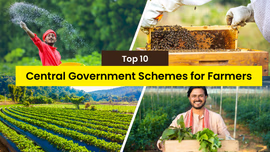National Livestock Mission: Objectives, Eligibility and How to Apply

Table of Contents
- Introduction
- What is the National Livestock Mission?
- Objectives of the National Livestock Mission
- Sub-Mission under National Livestock Mission
- Eligibility Criteria Under National Livestock Mission
- Subsidy Component Under National Livestock Mission
- New Activities Included in the National Livestock Mission
Introduction
The Livestock Sector in India is one of the critical sectors of the Indian economy, helping to boost agricultural growth and improve rural livelihoods. With 535.78 million livestock, India has the largest livestock population in the world (20th Livestock Census, 2019). India’s livestock population represents 11.6% of the global livestock.
The increase in income and urbanisation have led to an increase in the demand for animal protein, putting pressure on livestock to produce more. As a result, the livestock sector in India has grown faster than the crop sector over the last four decades.
However, per-animal productivity in India is lower than the global average. This is due to several factors, such as the dominance of indigenous low-yielding breeds, inadequate feed and fodder stock, and lack of entrepreneurship in the livestock sector. Besides, the majority of livestock farming is in the unorganised sector.
The Department of Fisheries, Animal Husbandry, and Dairy launched the National Livestock Mission in 2014 to address low productivity and promote entrepreneurship in the livestock sector.
What is the National Livestock Mission?
The National Livestock Mission (NLM) was launched by the Department of Fisheries, Animal Husbandry, and Dairy in 2014-15. The NLM Scheme aims to generate employment through entrepreneurship development in the poultry, piggery, small ruminants, and fodder sectors. It also aims to increase per-animal productivity and raise the production of milk, meat, eggs, and wool.
What are the Objectives of the National Livestock Mission?
- Animal Productivity: Increase per-animal productivity through breed improvement programmes.
- Livestock Produce: Increase the produce from livestock such as meat, eggs, milk, and wool.
- Employment Generation: Increase direct and indirect employment through entrepreneurship development in poultry, small ruminants, piggery, and fodder sectors.
- Fodder Availability: Reduce the demand-supply gap and increase the availability of feed and fodder through certified fodder seeds, strengthening the supply chain of fodder seeds and establishing fodder processing units.
- Livestock Insurance: Provide livestock insurance to farmers by promoting risk management measures.
- Capacity Building: Provide quality extension services to farmers by strengthening the extension machinery.
- Training: Promote training to enhance skills and disseminate technologies to reduce production costs and improve livestock sector production.
What are the Sub-Missions under National Livestock Mission?
The NLM Scheme has the following three submissions:
Sub-Mission on Feed and Fodder Development
It aims to strengthen the fodder seed supply chain and increase the availability of certified fodder seeds. Through incentivisation, it also encourages entrepreneurs to establish fodder blocks and hay-bailing units.
Sub-Mission on Breed Development of Poultry and Livestock
It focuses on entrepreneurship and breed development in livestock (cattle, pig, goat, and sheep) and poultry birds. To this end, it provides incentives to individuals, Farmer-Producer Organisations (FPOs), Joint Liability Groups (JLGs), and Self-Help Groups (SHGs).
Sub-Mission on Innovation and Extension
It aims to incentivise Universities and Research Organisations to carry out research related to the sheep, pig, goat, and fodder sector, livestock insurance, innovations, and extension services.
What are the Eligibility Criteria Under National Livestock Mission?
The following entrepreneurs and entities are eligible to avail of benefits under the NLM if they fulfil the below-given eligibility criteria:
- They should have trained experts or have obtained training in managing and running any livestock project.
- They should have got the loan sanctioned for the project from financial institutions or scheduled commercial banks. Besides, the loan-sanctioning bank should also have appraised the project to determine its validity.
- They should have sufficient experience or have trained experts with adequate experience in relevant fields.
- They should have all the relevant documents to meet the KYC norms.
- They should own or lease land where the project will be established.
What is the Subsidy Component Under National Livestock Mission?
The NLM Scheme provides a 50% subsidy on capital expenditure to aspiring entrepreneurs for setting up a cattle farm, pig farm, goat farm, poultry farm, and sheep farm. The maximum ceiling on subsidy varies as given below:
- Feed/Fodder Production: INR 50 lakhs*
- Pig Farm: INR 30 lakhs*
- Poultry Farm: INR 25 lakhs*
- Small Ruminants (Goat and Sheep) Farm: INR 50 lakhs*
- Cattle Farm: INR 2 crore*
Which New Activities are Included in the National Livestock Mission?
The Government of India in February 2024 included three additional activities under the NLM. These are:
Pack Animals
- Provide a 50% capital subsidy up to INR 50 lakhs for establishing entrepreneurs who handle pack animals such as donkeys, horses, camels, and mules.
- The central government will provide the state governments with INR 10 crores to breed and conserve pack animals.
Fodder Seed Processing Infrastructure
Provide 50% capital subsidy up to INR 50 lakhs for establishing entrepreneurs for Fodder Seed Processing Infrastructure such as fodder storage godowns.
Fodder Cultivation
To assist the state governments in promoting fodder cultivation in the non-forest land and wasteland/non-arable land/range land/ forest land. The aim is to increase the availability of fodder.
Livestock Insurance
- The premium share of the farmers is reduced to 15%, as opposed to the existing 20%, 30%, 40%, and 50%.
- The remaining premium amount to be shared between the Centre and the State is 60:40 for all states and 90:10 for hilly states.
- The number of animals to be insured has also been increased to 10 cattle, from 5 earlier.


Related Blogs












